Missing moose
By studying population patterns, scientists hope to figure out why moose in some areas are in trouble.
By Emily Sohn
For many years, moose were a mystery to me. On camping trips, I’d see fresh tracks and droppings, but no moose. On car trips, other people would see them and I’d be looking the wrong way.
When I was 18, a friend and I traveled through New England to Canada, mainly to see moose in the wild. We came home without a glimpse of these hefty animals.
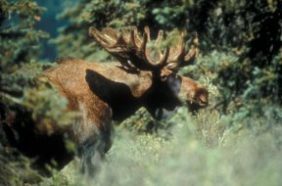 |
|
A bull moose in Alaska.
|
| U.S. Fish and Wildlife Service |
Today, seeing moose has become harder than ever in many places. Northwestern Minnesota, for instance, was home to about 4,000 moose in the 1980s. A 2003 survey turned up just 237.
And on Lake Superior’s Isle Royale in northern Michigan, a one-time population of 2,000 moose has fallen to 450, says Rolf Peterson. He’s a wildlife ecologist at Michigan Technological University in Houghton.
In other places, moose are doing just fine, but scientists are closely tracking their populations.
“As we do more and more timber harvesting and summer-home building and other things that affect moose habitat, we need to learn how to manage [these activities],” says John Pastor, an ecosystem expert at the University of Minnesota, Duluth. “We have an obligation to moose.”
Big eaters
Moose are among the largest land animals in North America. An adult male can weigh more than 1,000 pounds, including its 60-pound antlers. And they are striking creatures, with lanky legs, huge ears, and long noses. Their inch-wide nostrils shut tight when the animals swim.
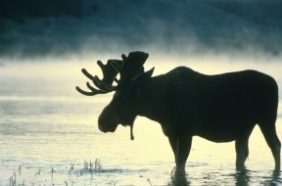 |
|
A bull moose wades in the water in search of food.
|
| Ralph Town, U.S. Fish and Wildlife Service |
One scientific mystery is the ability of moose to sustain themselves on leaves and twigs. They need 30 pounds of food a day, Pastor says. Because it takes as many as 3,000 bites to get this much food, feeding takes up most of a moose’s day.
All this eating can make a major dent in the forest. At Isle Royale, researchers count chomped twigs at sample sites to monitor how much gets eaten. The scientists also fence off sections of forest to compare chomped areas with nonchomped areas.
To determine the effect of moose nips on plant growth, scientists in Sweden clipped twigs at various heights to mimic the way moose eat. Their results showed that every time a moose bites a twig, the plant branches out instead of growing up. So, browsed birch, aspen, and willow get shrubbier, while uneaten spruce and pine grow taller. As a result, the moose’s preferred trees suffer in the shade.
 |
|
A grazing bull moose at the Kenai National Wildlife Refuge in Alaska.
|
| Mike Boylan, U.S. Fish and Wildlife Service |
But the grazing moose somehow seem to know when to call it quits. Studies suggest that before moving on, moose eat just enough from an area to fill themselves up but not so much that the forest can’t recover.
“It seems that moose have a detrimental effect on the forest, but somehow the forest survives,” Pastor says.
Moose are tied up in the food web in other ways. Spiders, snails, and insects, for example, depend on the plants that moose eat, so populations of these creepy crawlers change as moose browse.
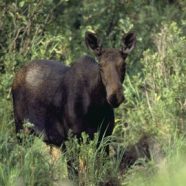 |
|
A cow moose at the Silvio O. Conte National Wildlife Refuge in Massachusetts.
|
| Ryan Hagerty, U.S. Fish and Wildlife Service |
At the other end of the food chain, moose and wolf populations seem to interact and fluctuate together, Peterson says.
Each winter for the past 47 years, researchers have counted populations of moose and wolf on Isle Royale. From an airplane, the scientists follow tracks in the snow. They keep track of the number of moose killed by wolves. When they find a dead moose, they record its age, sex, and other information.
The scientists have found that the number of old moose has the biggest impact on wolf populations. This is because wolves are more likely to attack older rather than younger moose. When there are lots of old moose in a certain area, there’s plenty of food for wolves, so their populations tend to go up.
Climate change
By studying population patterns, scientists hope to figure out why moose in some areas are in trouble. At this point, many signs appear to point to climate change.
Moose like cold weather, which explains why they range across Canada, the northern United States, Sweden, and other chilly places. Earth’s atmosphere has been warming in recent years, however, and temperatures are increasing fastest in the coldest places. As a result, the trees that moose like to eat are retreating to colder places. The animals must follow or starve.
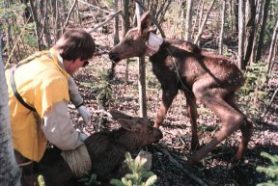 |
|
A researcher attaches a tracking collar to a moose calf.
|
| Jim Akaran, U.S. Fish and Wildlife Service |
Warmer weather also seems to make moose more vulnerable than usual to certain diseases, says Warren Ballard. He’s a population ecologist at Texas Tech University in Lubbock.
In northwestern Minnesota, for example, analyses of dead moose reveal that the creatures are dying at a rapid rate from brain worms and liver flukes, parasites that didn’t bother them much in the past. The animals are also low in some essential minerals, such as copper and selenium.
“We can’t say yet that there’s a cause and effect” between global warming and moose decline, Ballard says. “But it sure looks that way.”
There’s still hope for a happy ending for moose. When given a chance, their populations recover quickly, Pastor says. And moose continue to dominate the land in many places.
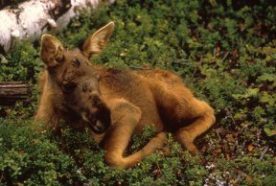 |
|
A moose calf.
|
| Leroy Anderson, U.S. Fish and Wildlife Service |
I finally had my first encounter with moose in Anchorage, Alaska, last summer. I was cycling on a city trail with friends when suddenly a mama moose and her calf blocked our way. For 15 minutes, we waited, afraid they would attack if we got too close. They were so big!
It was thrilling to see such a majestic animal up close, and my excitement lingered long after we managed to sneak by. As we passed, I’m happy to report, they looked strong and healthy to me.
Going Deeper:







